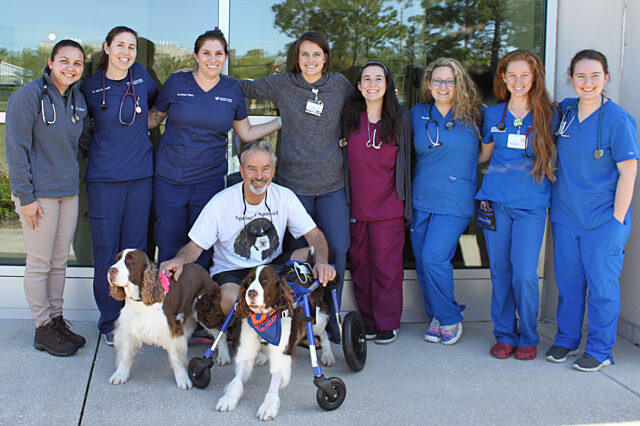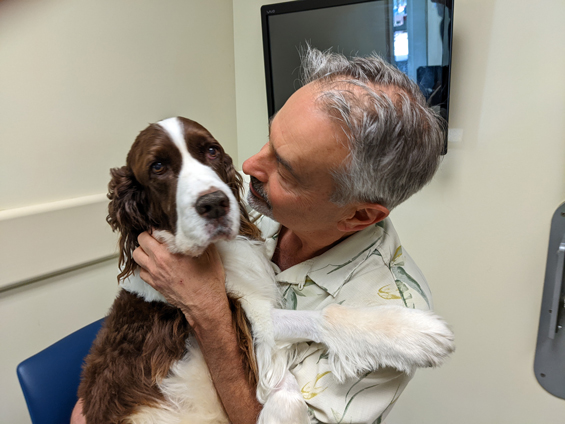Springer spaniel recovering well after treatment at UF for rare case of botulism

Video and additional images are located at Dog treated successfully for botulism at UF » College of Veterinary Medicine » University of Florida (ufl.edu)
Nearly a month after being discharged from the University of Florida’s Small Animal Hospital where he spent 30 days in the hospital’s ICU being treated for a rare case of canine botulism, a 12-year-old, liver-colored English springer spaniel named Luke has a spring in his step as he recovers at home.
“Luke continues to gain back his strength, but he is doing really well,” said Gareth Buckley, VetMB, a clinical associate professor of emergency and critical care at UF and chief veterinary officer for the UF Veterinary Hospitals.
On April 1, 10 days after his discharge, Luke’s care team at UF saw him for a recheck appointment, during which X-rays and bloodwork were taken. All tests showed continued improvement, Buckley said, adding that Luke has continued to progress and is receiving ongoing rehabilitation therapy at a clinic near his home in Orange City, Florida.
Luke is believed to have contracted the deadly neurotoxin after he devoured a carcass on an island he regularly visits with his owner, Neal Almond.
When Almond arrived at the hospital on March 21 to pick Luke up, he was met with a surprise send-off, as faculty and resident veterinarians, technicians and students who had cared for Luke gathered in a hallway to cheer for the devoted pair as they emerged from a treatment area near the ICU.
Almond has had Luke and his inseparable companion, Sassie — also a liver-colored springer spaniel, two years younger — since they were 8-week-old pups. He calls Sassie Luke’s “wife” because she once gave birth to a litter of 10 puppies that Luke sired and doted on.
“One of the greatest pleasures of being with them is watching their relationship,” Almond said. “They have such a tremendous bond. When Luke was in the hospital, Sassie was noticeably despondent. She is very happy that he is home.”
The two dogs always travel together — Almond calls them his “with” dogs, as they go with him everywhere — and Almond regularly takes them to the Blue Ridge Mountains, where they hike and swim, and boating at an island near New Smyrna Beach. It was on one such trip where Luke discovered and ate part of an animal carcass, which most likely caused him to develop botulism.
“We were out in a local freshwater lake on Feb. 18, and had landed at an island in the middle, ironically known as Dog Island,” Almond said.

Luke and Sassie love running freely on the island, swimming, retrieving sticks and “just generally living large,” Almond said. A short while after Almond reached the island with the dogs, Luke briefly went missing. Soon he reappeared, though, and as Almond proceeded to walk with both dogs around the island, Almond saw Luke gobbling something about 15 feet ahead.
“The smell was horrible and overpowering,” he said. He commanded Luke to get away from the foul carrion he was consuming, and tried to remove whatever had been in the dog’s throat, although he realized Luke had already ingested quite a bit of the carcass.
Within 24 hours, Luke had a hard time keeping up on his normal walk. A short time later, he began vomiting, which continued for nearly three hours, at which point he could no longer walk or stand.
A semi-retired pilot with a scientific and medical background, Almond is intrigued by microorganisms and immediately suspected botulinum poisoning. The emergency veterinarian Almond took Luke to suspected that Luke might need help breathing due to signs of paralysis, and recommended Almond take Luke to UF, one of very few veterinary hospitals in Florida with experience and expertise in managing patients that require mechanical ventilation.
Almond loaded Luke up and drove him to Gainesville just after midnight on Feb. 20.
“Luke’s initial tests and examination findings were suggestive of botulism, but it was a sample of fluid from his lung that showed the bacteria that causes the disease and confirmed the diagnosis,” said Taylor Curley, D.V.M., a resident with UF’s emergency and critical care team who treated Luke.
“Luke was in critical condition and needed to be intubated. He spent the next three days on the ventilator, constantly monitored, before being able to be awakened and extubated,” Curley said. “He subsequently underwent extensive rehabilitation, including physical therapy performed by UF’s integrative medicine team.”
Ten days after his discharge, Luke was doing well enough that his antibiotics were discontinued, although he is expected to continue physical therapy to regain his strength and muscle mass.
“It was such a pleasure to help care for Luke, and it truly does take a village to manage such a complex and critically ill patient as he was,” Curley said. “It is wonderful to see him recovering so well and continuing to regain his strength.” Botulism in dogs is rare, the UF veterinarians said. They hope to write up Luke’s case in hopes others may benefit from their experience in managing Luke’s successful treatment.
“Luke is my best friend. I love him,” Almond said. “He has a zest for life and is a very happy, joyful and contented boy. I was not ready to say goodbye, and, as we now know, neither was Luke. This was his strength. I had no decision to make as long as there was any possible hope.”
Almond said he was overwhelmed at the send-off his beloved dog received and how many people obviously cared for him.
“At every step along the way, the team that cared for Luke kept me updated and talked me through his condition and the treatment options available to us,” Almond said. “I knew he was in excellent hands, and will never forget the level of caring and professionalism that led to Luke’s successful outcome.”
Although dogs often roll around in or eat dead animals in their path without any harm beyond a foul odor, Luke’s rare case serves as a good reminder for pet owners “to follow their human instincts when it comes to keeping pets away from icky things they might otherwise want to explore,” Buckley said.
About the author
